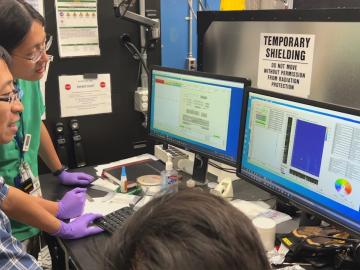
Filter News
Area of Research
- (-) Biology and Environment (34)
- (-) Neutron Science (48)
- (-) Nuclear Science and Technology (13)
- (-) Transportation Systems (1)
- Advanced Manufacturing (6)
- Biological Systems (1)
- Computational Biology (2)
- Computational Engineering (2)
- Computer Science (9)
- Electricity and Smart Grid (1)
- Energy Science (97)
- Energy Sciences (1)
- Functional Materials for Energy (2)
- Fusion and Fission (28)
- Fusion Energy (15)
- Isotope Development and Production (1)
- Isotopes (9)
- Materials (111)
- Materials Characterization (1)
- Materials for Computing (17)
- Materials Under Extremes (1)
- National Security (23)
- Quantum information Science (9)
- Sensors and Controls (1)
- Supercomputing (70)
News Topics
- (-) Biomedical (31)
- (-) Energy Storage (13)
- (-) Fusion (9)
- (-) Machine Learning (11)
- (-) Materials Science (32)
- (-) Quantum Science (7)
- (-) Security (4)
- 3-D Printing/Advanced Manufacturing (19)
- Advanced Reactors (12)
- Artificial Intelligence (14)
- Big Data (11)
- Bioenergy (53)
- Biology (78)
- Biotechnology (14)
- Buildings (2)
- Chemical Sciences (15)
- Clean Water (13)
- Composites (5)
- Computer Science (33)
- Coronavirus (21)
- Critical Materials (1)
- Cybersecurity (2)
- Environment (99)
- Exascale Computing (4)
- Fossil Energy (1)
- Frontier (4)
- Grid (3)
- High-Performance Computing (22)
- Hydropower (9)
- Isotopes (7)
- Materials (25)
- Mathematics (4)
- Mercury (7)
- Microscopy (13)
- Molten Salt (5)
- Nanotechnology (17)
- National Security (5)
- Neutron Science (122)
- Nuclear Energy (39)
- Partnerships (6)
- Physics (12)
- Polymers (3)
- Quantum Computing (1)
- Simulation (15)
- Space Exploration (8)
- Summit (15)
- Transportation (10)
Media Contacts

Scientists at ORNL used neutrons to end a decades-long debate about an enzyme cancer uses.

Daryl Yang is coupling his science and engineering expertise to devise new ways to measure significant changes going on in the Arctic, a region that’s warming nearly four times faster than other parts of the planet. The remote sensing technologies and modeling tools he develops and leverages for the Next-Generation Ecosystem Experiments in the Arctic project, or NGEE Arctic, help improve models of the ecosystem to better inform decision-making as the landscape changes.

Scientists at ORNL have developed 3-D-printed collimator techniques that can be used to custom design collimators that better filter out noise during different types of neutron scattering experiments

How do you get water to float in midair? With a WAND2, of course. But it’s hardly magic. In fact, it’s a scientific device used by scientists to study matter.

Four scientists affiliated with ORNL were named Battelle Distinguished Inventors during the lab’s annual Innovation Awards on Dec. 1 in recognition of being granted 14 or more United States patents.

Scientists at ORNL used their expertise in quantum biology, artificial intelligence and bioengineering to improve how CRISPR Cas9 genome editing tools work on organisms like microbes that can be modified to produce renewable fuels and chemicals.

Currently, the biggest hurdle for electric vehicles, or EVs, is the development of advanced battery technology to extend driving range, safety and reliability.

Neutron experiments can take days to complete, requiring researchers to work long shifts to monitor progress and make necessary adjustments. But thanks to advances in artificial intelligence and machine learning, experiments can now be done remotely and in half the time.

Madhavi Martin brings a physicist’s tools and perspective to biological and environmental research at the Department of Energy’s Oak Ridge National Laboratory, supporting advances in bioenergy, soil carbon storage and environmental monitoring, and even helping solve a murder mystery.

Mirko Musa spent his childhood zigzagging his bike along the Po River. The Po, Italy’s longest river, cuts through a lush valley of grain and vegetable fields, which look like a green and gold ocean spreading out from the river’s banks.


